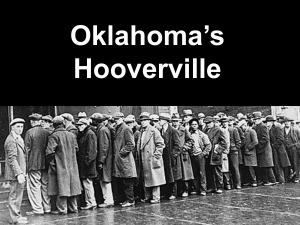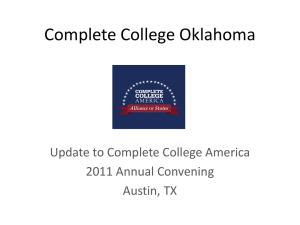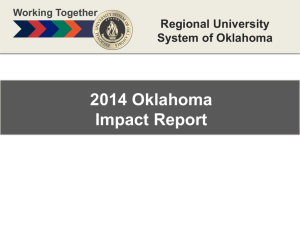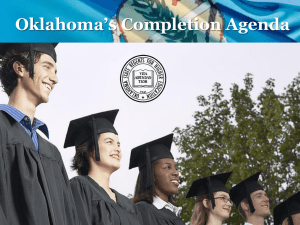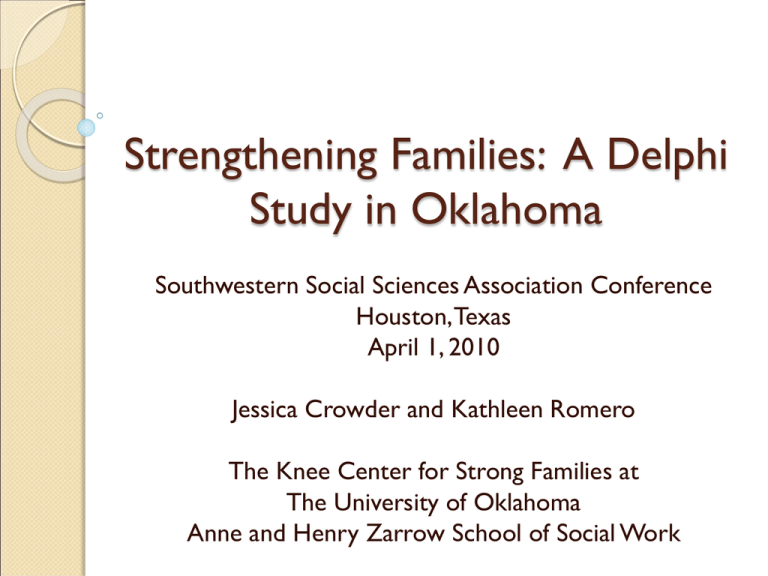
Strengthening Families: A Delphi
Study in Oklahoma
Southwestern Social Sciences Association Conference
Houston, Texas
April 1, 2010
Jessica Crowder and Kathleen Romero
The Knee Center for Strong Families at
The University of Oklahoma
Anne and Henry Zarrow School of Social Work
The Knee Center for Strong Families
Mission:
“The Knee Center for Strong Families is dedicated
to strengthening families in Oklahoma through
research, service, policy, and practice.”
Founded in 2009 through
a bequest of Ruth Knee, a
social work alumna from
the University of Oklahoma
Delphi Defined
Model Delphi Study:
◦ Therapists’ Views of Family Life: A Delphi Study
by Linda Stone Fish and Janet L. Osborn at Syracuse University
To examine strengths and weaknesses of families in the U.S.
Definition: a procedure that structures a communication
process among a group of experts (Linstone & Turoff, 1975)
Characteristics of the Delphi technique:
◦
◦
◦
◦
◦
Feedback of individual responses
Assessment of the group’s view
An opportunity for informants to revise their views
Opportunity to react to and assess differing view points
Anonymity of informants
Informants are selected based on their expertise in the
subject matter; not random
Fish, L.S. & Osborn, J.L. (1992). Therapists’ views of family life: A delphi study. Family Relations, 41, 409-416.
Survey Participants
Our selection procedure:
1. Utilized list of members of the Oklahoma
Association of Youth Services agencies in all
regions of state (N = 39)
2. Contacted directors to identify key informants
within agency
3. Sent Round 1 survey to 38 informants
4. Sent Round 2 survey to 38 informants
Round 1: 21 respondents, 17 completed
survey
Round 2: 20 respondents, 18 completed
survey
Methods
Utilized Survey Monkey
Round 1: Qualitative, open-ended questions
Round 2: Rate categorized responses
OU-IRB approval
Limitations of electronic communication
◦ Unable to reach some participants
◦ Some prefer hard copy (was offered by request)
Survey Participants
By location within Oklahoma
Collecting Demographic Information
Size
of community served:
Collecting Demographic Information
Years
worked at agency:
Collecting Demographic Information
Position title at agency:
Collecting Demographic Information
Years spent practicing with families:
Collecting Demographic Information
Terminal degree(s) held:
Round One Survey Questions
What are the current strengths of family life in
Oklahoma?
What are the current weaknesses of family life in
Oklahoma?
What are the major threats to family life in
Oklahoma in the next decade?
What does Oklahoma need to do as a state to
strengthen its families?
What can your agency do to strengthen
Oklahoma families?
What can The Anne and Henry Zarrow School of
Social Work do to assist your agency in
strengthening Oklahoma families?
Strengths of Family Life in Oklahoma
Round One Raw Response Data:
◦ “Many parents work hard to provide economically for their families and
are teaching strong morals and values to their children including
religious upbringing and training. These same families are most often
actively involved in their children’s social lives including participating in
the extra-curricular activities in which their children participate.”
Round Two Response Categories:
◦ Availability of support systems (extended family, community, schools,
etc.)
◦ Well-bonded families (extensive family involvement, emotional
connection among members)
◦ Participation in family activities (including sports, extracurricular
activities, community events)
◦ Resilience (capacity to overcome hardships)
◦ Value orientation toward family life (placing family life as a priority)
◦ Spirituality (including faith in a higher power, faith community
involvement)
◦ Material provisions are met (food and shelter, low cost of living)
Weaknesses of Family Life in Oklahoma
Round One Response Data:
◦ “Although families are close, there
seems to be problems that
perpetuate throughout generations.”
◦ “Parents lack adequate parenting
skills and pay little attention to
emotional and psychological
development of their offspring.”
Round Two Response Categories:
◦ Reduced social-physical well-being
◦ Criminal behavior by parents or
family members
◦ Lack of relationship-building
education (conflict resolution,
communication skills)
◦ Poverty (low wages, single earners,
low incomes, etc.)
◦ People having children too early
(including teenage parenting)
◦ Busy lifestyles/lack of
communication
◦ Economic stressors (including debt,
fear of income loss, etc.)
◦ Substance abuse
◦ Lack of education/quality of
education
◦ Lack of parenting/life skills
◦ Children raised by grandparent/nonparent because of some parental
absence
◦ Divorce rates
◦ Generational cycles of dysfunction
◦ Domestic abuse
◦ Lack of employment opportunity
◦ Incarceration of a family member
◦ Lack of programs/resources
(particularly in rural areas)
◦ Lack of inpatient care for adolescents
◦ Single-parent homes
◦ Disinterested parents
◦ Lack of care for elderly family
members
◦ Child abuse
Major Threats to Family Life in
Oklahoma in the Next Decade
Round One Response Data:
◦
◦
“The movement to eliminate programs
and services that work with low income
families under the flag of shrinking
government.”
“Current statistics report that Oklahoma
is not doing well on many factors of
health including the [incidence] of
abuse/neglect and child death. Oklahoma
must act quickly to attempt to decrease
these areas. Much of Oklahoma resources
are spent on a small area of urban growth
downtown with little attention to social
problems in our state.”
Round Two Response Categories:
◦
◦
◦
◦
◦
◦
◦
Crime
Poverty
Generational cycles of dysfunction
Work and other commitments overtaking
home life
Single parenthood
Children being raised by a non-parent
Child abuse/neglect/mortality rates
◦
◦
◦
◦
◦
◦
◦
◦
◦
◦
◦
◦
◦
◦
◦
◦
Physical and sexual abuse
Lack of education/quality of education
Lack of access to social services
Poor health
Substance abuse/addiction
Parental incarceration
Domestic violence
Lack of health care
Lack of adequate employment (underemployment, low wages)
State budget reduction of social services
Communities that offer more instant
gratification activities (such as movies,
video game arenas, malls, etc.) than
community parks and activities
Gang violence
Economic downturn
Gambling
Divorce
People having children too early (including
teenage parenting)
What Oklahoma Needs to Do to
Strengthen its Families
Round One Response Data:
◦
“Focus on school system and more prevention
type programs for school age kids.”
◦
“Increase preventative services through DHS
such as parenting, budgeting, and better job
placement services to improve families from the
beginning.”
Round Two Response Categories:
◦
Prevention and intervention efforts for domestic
violence
◦
Support grandparents raising grandchildren
◦
Reduce incarceration rates through communitybased sentencing
◦
Develop and fund more inpatient facilities for
substance abuse
◦
Improve efficiency of service delivery systems
◦
Teach reproductive health care and support birth
control/school-based sex education and
pregnancy prevention
◦
Increase funding for treatment of substance abuse
and mental health issues
◦
Provide job training
◦
Care for aging family members
◦
Promote importance of mental, emotional, and
physical health
◦
Fund prevention efforts (including school-based
efforts)
◦
Provide mentoring for children
◦
Allocate more state funding to social services
◦
Support parents as role models
◦
Support educational and employment
opportunities
◦
Restructure agencies to provide services that are
more inclusive of whole family unit
◦
Promote economic development
◦
Reduce dependence on social welfare programs
◦
Shrink state agencies
◦
Teach parenting/life skills (debt management, job
searching, etc.)
◦
Prevention and intervention efforts for drug and
alcohol abuse
◦
Premarital counseling/marriage preparation
classes
◦
Reach out to rural communities/provide
incentives for utilization of social services in
smaller communities
What Family-Oriented Agencies can do
to Strengthen Oklahoma Families
Round One Response Data:
◦ “We attempt to engage the entire family in our
services. This makes it imperative that we engage
and empower parents with communication and
parenting skills necessary to raise youth in a loving
and predictable environment.”
◦ “Create and find funding for prevention programs.”
◦ “Continue focus on community action at the
grassroots level involving community and reaching
the largest population we can.”
What the Anne and Henry Zarrow School of
Social Work Can do to Assist Family-Oriented
Agencies in Strengthening Oklahoma Families
Round One Response Data:
◦ “Provide our agency with training opportunities and
literature that helps us to be better informed of the
needs of families in Oklahoma and how to meet those
needs.”
◦ “Focus on community prevention and community
development at a grassroots level. Develop community
leaders. Consider ways to strengthen the rural
community resources and ways to provide incentives
for social workers to practice in these areas.”
◦ “Continue to prepare future social workers with a
strengths-based systemic approach to service delivery.
Also, encourage advocacy in the areas of education,
employment and treatment.”
Round Two Survey Questions
What are the current strengths of family
life in Oklahoma?
What are the current weaknesses of
family life in Oklahoma?
What are the major threats to family life
in Oklahoma in the next decade?
What does Oklahoma need to do as a
state to strengthen its families?
Family Strengths
1.
2.
3.
4.
5.
Resilience (4.85)
Spirituality (4.55)
Availability of support systems (4.55)
Well-bonded families (4.45)
Value orientation toward family life (4.45)
Material provisions are met (4.20)
Participation in family activities (3.90)
Family Weaknesses
1.
2.
3.
4.
5.
6.
7.
8.
9.
10.
Substance abuse (5.35)
Poverty (5.25)
Generational cycles of dysfunction (5.15)
Lack of parenting/life skills (5.05)
Lack of programs/resources (particularly in rural areas) (5.05)
Economic stressors (5.00)
Lack of relationship-building education (4.85)
Child abuse (4.75)
Criminal behavior by parents or family members (4.75)
Lack of employment opportunity (4.75)
Divorce rates (4.70)
People having children too early (including teen parenting) (4.70)
Domestic abuse (4.63)
Children raised by non-parent because of parental absence (4.60)
Threats to Families
1.
2.
3.
4.
5.
6.
7.
8.
9.
10.
Poverty (5.22)
State budget reduction of social services (5.11)
Substance abuse/addiction (5.06)
Economic downturn (5.00)
Generational cycles of dysfunction (4.94)
Lack of adequate employment (4.78)
Lack of health care (4.78)
Child abuse/neglect/mortality rates (4.72)
Domestic violence (4.72)
People having children too early (4.61)
Physical and sexual abuse (4.61)
Lack of education/quality of education (4.56)
Poor health (4.56)
Work and other commitments overtaking home life (4.50)
What can the State of Oklahoma do
to Strengthen Families?
1.
Increase funding for treatment of substance abuse and mental health issues (5.33)
2.
Restructure agencies to provide services that are more inclusive of the whole family
unit (5.28)
Prevention and intervention efforts for drug and alcohol abuse (5.28)
3.
Promote importance of mental, emotional, and physical health (5.22)
Support educational and employment opportunities (5.22)
4.
Teach parenting/life skills (5.17)
5.
Promote economic development (5.11)
Fund prevention efforts (including school-based efforts) (5.11)
6.
Reach out to rural communities/provide incentives (5.06)
7.
Support grandparents raising grandchildren (5.00)
8.
Support parents as role models (4.94)
Provide mentoring for children (4.94)
Provide job training (4.94)
Allocate more state funding to social services (4.94)
9.
Teach reproductive health care and support birth control/school-based sex education
and pregnancy prevention (4.83)
10.
Prevention and intervention efforts for domestic violence (4.72)
Further
Research
National and Oklahoma centers study
“State of Oklahoma Families” publication
Same Delphi study with:
Academics
Policy-makers
We welcome your input on future research—
Questions?
The Knee Center for Strong Families
Anne and Henry Zarrow School of Social Work
1005 S Jenkins
Norman, Oklahoma 73019
Phone: (405) 325-2821
Email: kwedel@ou.edu
Web: www.ou.edu/socialwork/knee


